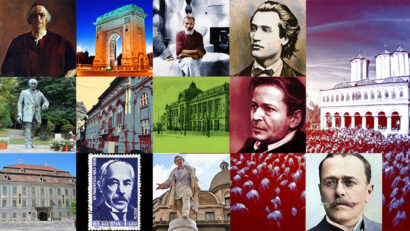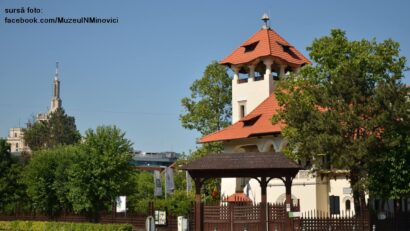Dimitrie Cantemir, the musician
A talks with musician Bogdan Simion about Dimitrie Cantemir's legacy in the field of music.

Christine Leșcu, 07.07.2024, 14:00
Celebrated
in 2023 on the anniversary of 350 years since his birth and 300 years
since his death, the ruler and scholar Dimitrie Cantemir was born in
1673 in Iași and died on his estate in Russia in 1723. Cantemir led
the principality of Moldavia in 1693 and again between 1710 and 1711,
fought to defend his country, read and wrote works of history,
geography, musicology, philosophy and literature and was even
admitted into the Berlin Academy of Sciences, being recognised to
this day as the first promoter of the Enlightenment in these parts.
Endowed with great intellectual abilities, Dimitrie also benefited,
together with his brother Antioh, of a good education, secured by
their father Constantin Cantemir. The latter also ruled over
Moldavia, but was not himself educated, and it is even believed he
was semi-illiterate. When he was young, Dimitrie was sent as a
hostage to the High Porte in Istanbul, as was the custom at the time
as a way for the sultan to secure the loyalty of the voivodes of the
Romanian principalities that were vassal states to the Ottoman
Empire. During his time in Istanbul, the future ruler furthered his
education and training, learning to speak several languages,
acquiring knowledge of theology and philosophy and studying music. He
would excel at Oriental music, which was dominant in this part of
Europe. His contribution in this field was crucial at a time when
there were no musical scores in these lands, the musician Bogdan
Simion explains:
Before Cantemir we didn’t have manuscripts in these parts and
even his manuscripts are very complicated to read and especially to
perform. First of all, because there is no indication of tempo, we
don’t know how fast or how slow the tunes in question are to be
played. Of course, we can establish that by looking at Iranian,
Afghan and Turkish music and imagine a kind of prolonged tempo. Other
indications in this respect are given by foreign travellers who
listened to the respective music. Cantemir, however, invented a music
notation system. We, in the Romanian countries, didn’t write music
before Anton Pann and his Hospital of Love work of 1851, that was
already a different era and Pann was using the Byzantine musical
notation, like in church chants. Cantemir invented a system that was
relatively easy to write down and interpret, easy to use and which
the composers at the court of the sultan of the Ottoman Empire
adopted and used until 1900, so it was quite good. Travelling to
Istanbul I was surprised to learn that Dimitrie Cantemiroglu, as the
Ottomans called him, is remembered first and foremost as a pioneer of
Turkish music in the Ottoman Empire. It isn’t much known that he
was a ruler or that he wrote works of geography and philosophy or
that he spoke Latin or that he was a member of the Berlin Academy.
Dimitrie Cantemiroglu is believed instead to come from a province of
the Ottoman Empire, perhaps being of Tartar origin himself, and of
leaving an extraordinary mark on Turkish musical culture.
Dimitrie
Cantemir’s main contribution is a treatise of musicology entitled
The Book of Science of Music, most probably written in Istanbul
between 1695 and 1700. Musician Bogdan Simion tells us more:
The Book of Science of Music was written in Arabic and was
dedicated to sultan Ahmed III, a great patron of the arts and a man
passionate about culture in general. It’s a work many specialists
describe as more political than cultural. In the 17th
century, Cantemir was asked to demonstrate that there was such as
thing as an identifiable Turkish music. Around 1700, there was a
heated debate in the Ottoman Empire, as many Turkish thinkers argued
there was no Turkish culture as such, but that this was in fact a
lower form of Persian culture. This book appeared around 1700 in
Istanbul, which at the time was a very cosmopolitan city and home not
only to Muslim thinkers and philosophers, but also the wisest and
most widely read Orthodox Greeks, with whom Cantemir had excellent
ties, as he never renounced his Orthodox faith. So, there were voices
in Istanbul saying there was no such thing as Turkish culture and
that Ottoman culture was the sum of a number of ancient cultures, of
which the noblest and highest was that of the Persians. Naturally,
sultan Ahmed wanted the brilliant young man to demonstrate that this
was not so. In the forward, the author makes a diachronic historical
analysis of music genres, after which he embarks on the treatise
itself and the musical scores. At the end, which is the most
interesting part for us, he included some original compositions,
drawing on Sephardic sounds from North Africa and even a series of
suites he calls ‘Moldavian’. Of course, listening to the latter
today they sound as if they are entirely from Istanbul. No Romanian
today will say they recognise anything of what we today call
traditional music, but if we travel to the north of Moldavia, to
Botoșani, the Tartar Bugeac, the
centre of what is today the Republic of Moldova and if we listen to
certain kobza tunes we understand that Oriental music influenced the
music on the outskirts of towns and later even village music,
following the abolition of Roma slavery.
As
someone who knew the Ottoman Empire well, having also written a work
entitled The Rise and Fall of the Ottoman Porte, Dimitrie Cantemir
tried to free Moldavia from under the sovereignty of the Sublime
Porte, joining forces with Peter the Great against it. His plan,
however, failed following the defeat at Stănilești in 1711. Forced
to flee to Russia, he would spend the rest of his life as an advisor
at the court of Peter the Great. His remains were brought back to
Romania in 1935 and were buried at the Three Hierarchs’ Church in
Iași.





























